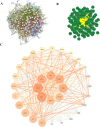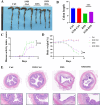Si-Ni Decoction as a Potential Treatment for Ulcerative Colitis: Modulation of Gut Microbiota and AKT1 Inhibition Through Network Pharmacology and in vivo Validation
- PMID: 40391232
- PMCID: PMC12087465
- DOI: 10.2147/JIR.S516556
Si-Ni Decoction as a Potential Treatment for Ulcerative Colitis: Modulation of Gut Microbiota and AKT1 Inhibition Through Network Pharmacology and in vivo Validation
Abstract
Background: Sini Decoction (SND), a time-honored formulation in traditional Chinese medicine, consists of three key ingredients: aconite, licorice, and ginger rhizome. It has been used for more than a thousand years to relieve symptoms associated with acute gastroenteritis, dyspepsia, and abdominal discomfort, but its therapeutic efficacy in ulcerative colitis (UC) and the mechanisms involved have not been validated. In this study, a comprehensive approach integrating network pharmacology, molecular docking, molecular dynamics simulation and experimentation was used to assess the efficacy of SND in the treatment of UC and to explore its molecular mechanisms.
Methods: The bioactive compounds associated with ulcerative colitis (UC) were identified using the TCMSP database, with potential targets predicted via the Swiss Target Prediction database. Protein-protein interaction networks were constructed using the STRING database and Cytoscape and the most important genes were identified. Subsequently, molecular docking was combined with molecular dynamics simulations using molecular docking to assess the binding affinity of the main active ingredient of SND to AKT1. To evaluate the therapeutic effects of SND, we utilized a dextran sodium sulfate-induced UC mouse model. Additionally, fecal samples were collected for analysis of the intestinal microbiota to explore the influence of SND on gut flora composition.
Results: Fifteen bioactive components from SND were identified, and their activities were validated. The results indicated that AKT serine/threonine kinase 1 is a core target of SND for the treatment of UC. The anti-inflammatory, intestinal barrier-protective, and microbiota-regulating effects of SND were confirmed in animal models, alongside evidence of its inhibitory effect on AKT1.
Conclusion: The active ingredients of SND were screened, with a focus on AKT1 inhibition, to reduce inflammation in UC, protect the intestinal barrier, and regulate the intestinal microbiota, demonstrating significant therapeutic potential.
Keywords: gut microbiota; intestinal barrier; molecular docking; network pharmacology; sini decoction; ulcerative colitis.
© 2025 Shi et al.
Conflict of interest statement
The authors declare that there are no conflicts of interest.
Figures











Similar articles
-
Integrated Network Pharmacology, Molecular Docking and Animal Experiment to Explore the Efficacy and Potential Mechanism of Baiyu Decoction Against Ulcerative Colitis by Enema.Drug Des Devel Ther. 2023 Nov 23;17:3453-3472. doi: 10.2147/DDDT.S432268. eCollection 2023. Drug Des Devel Ther. 2023. PMID: 38024534 Free PMC article.
-
Thlaspi arvense suppresses gut microbiota related TNF inflammatory pathway to alleviates ulcerative colitis.Front Immunol. 2025 Apr 22;16:1537325. doi: 10.3389/fimmu.2025.1537325. eCollection 2025. Front Immunol. 2025. PMID: 40330488 Free PMC article.
-
The potential mechanism of Bletilla striata in the treatment of ulcerative colitis determined through network pharmacology, molecular docking, and in vivo experimental verification.Naunyn Schmiedebergs Arch Pharmacol. 2023 May;396(5):983-1000. doi: 10.1007/s00210-022-02370-9. Epub 2022 Dec 28. Naunyn Schmiedebergs Arch Pharmacol. 2023. PMID: 36576506 Free PMC article.
-
Comparison of the molecular mechanisms of Fuzi Lizhong Pill and Huangqin decoction in the treatment of the cold and heat syndromes of ulcerative colitis based on network pharmacology.Comput Biol Med. 2023 Jun;159:106870. doi: 10.1016/j.compbiomed.2023.106870. Epub 2023 Apr 5. Comput Biol Med. 2023. PMID: 37084637
-
Traditional Chinese Medicine: A promising strategy to regulate the imbalance of bacterial flora, impaired intestinal barrier and immune function attributed to ulcerative colitis through intestinal microecology.J Ethnopharmacol. 2024 Jan 10;318(Pt A):116879. doi: 10.1016/j.jep.2023.116879. Epub 2023 Jul 5. J Ethnopharmacol. 2024. PMID: 37419224 Review.
References
LinkOut - more resources
Full Text Sources
Miscellaneous

